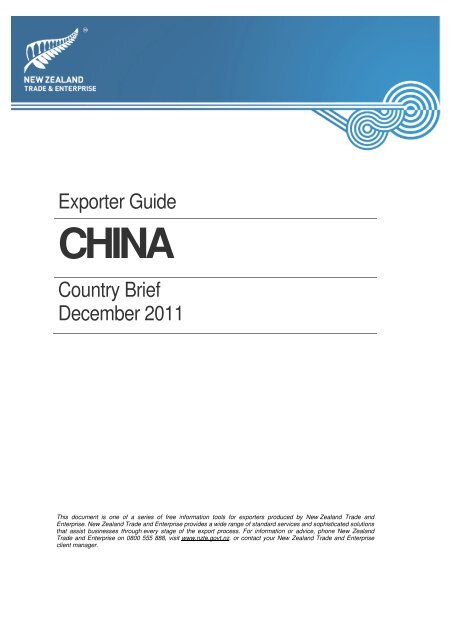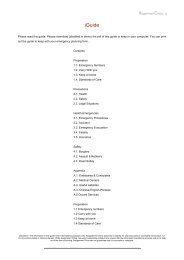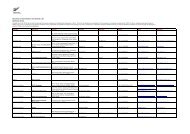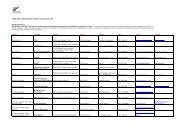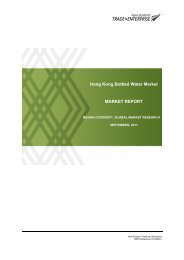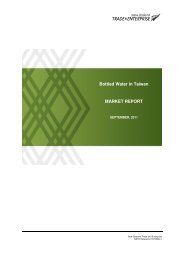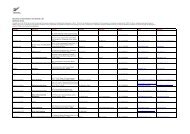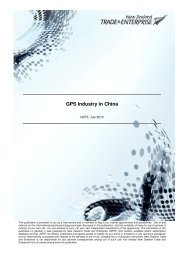China Country Brief - December 2011.pdf - PrcLive
China Country Brief - December 2011.pdf - PrcLive
China Country Brief - December 2011.pdf - PrcLive
Create successful ePaper yourself
Turn your PDF publications into a flip-book with our unique Google optimized e-Paper software.
Exporter GuideCHINA<strong>Country</strong> <strong>Brief</strong><strong>December</strong> 2011This document is one of a series of free information tools for exporters produced by New Zealand Trade andEnterprise. New Zealand Trade and Enterprise provides a wide range of standard services and sophisticated solutionsthat assist businesses through every stage of the export process. For information or advice, phone New ZealandTrade and Enterprise on 0800 555 888, visit www.nzte.govt.nz, or contact your New Zealand Trade and Enterpriseclient manager.
CONTENTSKEY INDICATORS 3OVERVIEW 3POLITICAL 4BILATERAL TRADE 5SECTOR OPPORTUNITIES 5USEFUL WEBSITES 6CONTACTS 112/Exporter Guide | <strong>China</strong> | <strong>Country</strong> <strong>Brief</strong> | <strong>December</strong> 2011
KEY INDICATORSECONOMIC INDICATORPopulationGDPGDP Growth RateGDP Per CapitaInflationCHINA1.35 billion (2011 est.)US$6,988 billion (2011 est.)9.5% (2011 est.)US$5,184 (2011 est.)5.5% (2011 est.)Total Imports US$1.39 trillion (2010)Total Exports US$1.58 trillion (2010)Currency1 Chinese Yuan (Renminbi) = 100 fenExchange Rate NZ$1 = RNB 5.12US$1 = RNB 6.36Source: IMF World Economic Outlook Database, Global Trade Atlas, XE currency converter www.xe.comOVERVIEW<strong>China</strong> and New Zealand<strong>China</strong> is New Zealand’s second-largest trading partner, as well as a major source ofmigrants, students and tourists. In 2008, New Zealand became the first and only OECDcountry to conclude a Free Trade Agreement (FTA) with <strong>China</strong>. Since the signing of theFTA, New Zealand’s exports to <strong>China</strong> have grown by 152 percent, from NZ$2.3 billion (YESeptember 2008) to NZ$5.8 billion (YE September 2011), a figure which substantiallyexceeds pre-FTA modelling of potential export growth. Dairy products account for over athird of all exports to <strong>China</strong>, with other key exports being wood, wool, seafood and meat. iService sector exports are also growing, with education and tourism the majorcontributors. <strong>China</strong> was New Zealand’s largest market for foreign students in 2010. iiEconomyEconomic reforms and the opening up of <strong>China</strong> to the outside world have transformedChinese society, resulting in the largest reduction of poverty and one of the fastestincreases in income levels ever seen. In 2010, <strong>China</strong> overtook Japan to become theworld’s second-largest economy in terms of gross domestic product (GDP), behind theUnited States. iii For foreigners the transformation provides unprecedented businessopportunities.3/Exporter Guide | <strong>China</strong> | <strong>Country</strong> <strong>Brief</strong> | <strong>December</strong> 2011
due to an expected weakening in external demandstemming from the European debt crisis, the World Bank has lowered its growth forecastsfor <strong>China</strong>, predicting growth of 9.1 and 8.4 percent respectively in 2011 and 2012.<strong>China</strong> has the fastest-growing manufacturing sector in the world and has become thepreferred destination for the relocation of global manufacturing facilities. The industrialsector accounted for 46.8 percent of GDP in 2010, with the major industries being miningand ore processing, iron, steel, aluminum, coal, machinery, textiles and apparel,chemicals, consumer electronics, automobiles and telecommunications equipment. Whileagriculture only contributes around 10 percent of GDP, it accounts for more than 40percent of the labour force and <strong>China</strong> is among the world's largest producers of rice, corn,wheat, soybeans, vegetables, tea and pork. With the expansion of the manufacturing andservice sectors, there is an increasing movement of labour away from agriculture intoannumiv. However,its reform, it has maintained an average GDP growth rate of close to 10 percent per began <strong>China</strong> Sincesectors.iiitheseSome major changes are expected to occur in <strong>China</strong> over the next decade, in particularan increasingly ageing population. By year 2017 people aged 40 years and over willconstitute approximately 52 percent of the population. There is also a new generation ofconsumers emerging from <strong>China</strong>'s years of economic hardship. They can becharacterised as young, well educated and familiar with non-Chinese cultures, with a highprobability of becoming employees of multinationals or Chinese companies that areoperating internationally. This growing middle class is typically located in the major citieson the Eastern seaboard of <strong>China</strong> and in particular in the following four cities - Beijing,Shanghai, Shenzhen and Guangzhou.Average household income is forecast to grow at an annual growth rate of 4.2 percent.Nevertheless, significant differences remain between urban and rural household incomes.On average, incomes of rural households are less than a third of those in urbanhouseholds, and this difference is forecast to remain the same over the next decade.Investment and Foreign TradeEntry into the World Trade Organization (WTO) has allowed greater volumes of importedforeign agricultural products into the main centres, predominantly around Shanghai,Beijing and Guangzhou. This continues to be an issue for the Chinese government as itgrapples with the need to revitalise its rural sectors and urbanise a large proportion of therural population. Already some 80 million people have left their place of registration to findwork in the cities and more will likely follow unless economic development of the ruralregions is achieved.Since it began its open door policy in 1978, foreign trade has become more important to<strong>China</strong>. <strong>China</strong> is now one of the world’s largest trading nations and was the seventh4/Exporter Guide | <strong>China</strong> | <strong>Country</strong> <strong>Brief</strong> | <strong>December</strong> 2011
country to achieve a US$1 trillion economy. Its key trading partners are the United States,Hong Kong, Japan, South Korea and Germany. Low labour rates, an educated workforceand attractive investment policies have encouraged a large number of companies fromother markets to move production to <strong>China</strong>, particularly Hong Kong and Taiwanesecompanies. The output of these enterprises now constitutes a large portion of <strong>China</strong>’stotal exports.POLITICAL<strong>China</strong>’s Government has a communist constitution. Following almost thirty years ofpolitical unrest, the Chinese Communist Party (CCP) established <strong>China</strong>’s current systemof government in 1949. The country remained virtually closed to the world until a fewyears before the death of Mao Tse Tung in 1976. A new era began when US PresidentNixon made a historic visit to <strong>China</strong> in 1972, ending Beijing’s isolation from the noncommunistworld. Diplomatic relations with New Zealand were established shortly after on22 <strong>December</strong> 1972; the United States achieved this in 1979.Since the late 1970s, a series of five-year plans have aimed to modernise agriculture,industry, science, technology and national defence while expanding the production ofconsumer goods, housing construction, energy and transport. Reform of the finance,taxation, foreign trade and investment sectors was begun in the 1980s and has beenongoing since then.In March 2008, the 11th National People’s Congress (NPC) in Beijing elected <strong>China</strong>’s newgovernment leaders. President Hu Jintao and Premier Wen Jiabao were confirmed for asecond term (both have visited New Zealand – Hu in 2003 and Wen in 2006)BILATERAL TRADE<strong>China</strong>’s imports tend to be capital plant and equipment, raw materials or semi-processedproducts for use by domestic industry for processing and re-export, and specialistproducts that Chinese companies cannot yet produce to the required standard. NewZealand’s exports to <strong>China</strong> are predominantly primary sector products such as wool,dairy, meat, seafood and wood products. This is unlikely to change in the near future.New Zealand’s export trade with <strong>China</strong> over the last two years has grown faster than withany other major nation over the same period in New Zealand’s trading history. In the yearto September 2011, exports to <strong>China</strong> grew by 35 percent and represent 12.4 percent ofNew Zealand’s total exports. <strong>China</strong> is the second largest source of imports for NewZealand. Imports from <strong>China</strong> increased by 13.8 percent in the year to September 2011,reaching NZ$6.9 billion. i5/Exporter Guide | <strong>China</strong> | <strong>Country</strong> <strong>Brief</strong> | <strong>December</strong> 2011
SECTOR OPPORTUNITIES<strong>China</strong> offers significant business opportunities for New Zealand companies. Sectorswhere New Zealand companies may have a value proposition that is commerciallyfeasible in the <strong>China</strong> market include the following.Food and BeveragesChinese consumers are looking for safe, quality products. As disposable incomes riseconsumers can afford better quality products and are more focused on wellbeing. Theyare increasingly looking for the healthiest and freshest quality foods. New Zealand’sreputation as a clean and green environment, with an unblemished food safety record,means our products have an edge. In addition, the Chinese are increasingly looking forconvenience products. Wet markets and produce markets are losing their dominance asmore consumers are drawn to hypermarkets and restaurants. This opens up significantopportunities for New Zealand’s quality foods.New Zealand already exports significant volumes of dairy products: mainly bulk milkpowder but also cream, cheese, butter and yoghurt. In the year to September 2011, NewZealand’s dairy exports to <strong>China</strong> were worth NZ$2.13 billion. New Zealand also exportslarge volumes of meat, mainly low value lamb and offal. There are niche opportunities tosupply higher value-added meat cuts to the retail and hotel, restaurant and institutional(HRI) sectors in major cities. New Zealand’s seafood exports to <strong>China</strong> have grown by 84percent in the 12 months to September 2011 and <strong>China</strong> is now New Zealand’s secondlargest export market for fish and seafood. This is predominantly for manufacturing butthere is also a growing component of high value fresh seafood.The Chinese market for domestic and imported wine has been developing rapidly, thoughit is still a small part of the alcoholic drinks market. The largest market for imported wine is“on-premise”, at top-end hotels, restaurants, bars and nightclubs. Four and five-starhotels, Western restaurants and upscale local chain restaurants generally carry aselection of local and imported wines. The retail market for imported wines is alsogrowing. Foreign supermarket chains normally have a wine corner at outlets located inmiddle to high income districts. High-end domestic department stores also carry importedwine, as do independent wine shops.InfrastructureWhile <strong>China</strong> has made huge efforts to upgrade its transport infrastructure in the developedcoastal provinces, the central and western regions are still far from being well connectedto the industrial hubs along the coast. Accordingly, the Chinese government hasdeveloped initiatives to push development westwards. While <strong>China</strong>'s road and rail networkhas high potential for expansion, the airport sector has the biggest need for upgrading.Covering 9.6 million sq km (about the same land size as the US), <strong>China</strong> operated only 1466/Exporter Guide | <strong>China</strong> | <strong>Country</strong> <strong>Brief</strong> | <strong>December</strong> 2011
civil airports in 2006, compared with 550 airports in the US and 280 in the EuropeanUnion.<strong>China</strong> will spend US$64 billion to build 97 airports throughout the country by 2020. Theseambitious plans will nearly double the number of airports available for commercial use to244, up from 147 in 2006. Over the next 20 years, <strong>China</strong> predicts that its airtransportation passenger volume will grow 8.5 percent annually, becoming the world’ssecond largest aviation market.Information and Communications TechnologyThe Information and Communications (ICT) industry in <strong>China</strong> covers a wide range ofproducts from low to high-end technologies. Demand for telecommunication services ispredicted to grow as the government continues its programme for increased services.Demand for IT products will come from major infrastructure projects, government,telecommunications, finance, energy, education and transport projects.The Chinese government has placed great emphasis on developing the high technologysector. Measures have included providing policy incentives, establishing high-tech zonesand providing development funding. It has also focused on developing basic softwarecapability, integrated systems, large scale key application software and next-generationinternet projects.Nutraceuticals / Health ProductsThe increasingly ageing population will ensure that the demand for healthcare and relatedproducts continues to rise. Natural health products, like calcium-based, marine-derivedand bee products, have undoubtedly good prospects in <strong>China</strong>, both in terms of supplyingbulk ingredients for re-branding and for launching New Zealand-branded product into theretail sector. Stiff competition from United States, European and Australian suppliers canbe expected in this sector. New Zealand companies will need to pay particular attentionto the strict regulations and registration procedures that apply to nutraceuticals andrelated health products in <strong>China</strong>.Wood Products<strong>China</strong> imported US$11.2 billion of wood in 2010, of which $US937 million was importedfrom New Zealand, increasing by nearly 70 percent compared with 2009 figures. NewZealand’s exports to <strong>China</strong> have historically been dominated by logs and lumber, thereare also opportunities for New Zealand companies to add value to their offering to <strong>China</strong>.The building boom continues across many of <strong>China</strong>’s main cities, opening upopportunities around interior fit outs and landscaping for both residential and commercialpurposes.New Zealand pine logs have traditionally been used in the construction industry, mainlyfor concrete forming, packaging and for the core of plywood. In recent years however,better quality New Zealand pine logs have been processed in <strong>China</strong> and the timber is7/Exporter Guide | <strong>China</strong> | <strong>Country</strong> <strong>Brief</strong> | <strong>December</strong> 2011
eing used in furniture and other value-added wood products for re-export and domesticmarket applications.While <strong>China</strong>’s furniture and finished goods industry will remain a key market for NewZealand pine timber, the rapid rise in <strong>China</strong>’s fit out and construction markets offersopportunities for New Zealand pine timber. There is also a growing demand for treatedtimber, especially for landscaping.Agritechnology<strong>China</strong>’s budding dairy industry has been identified as one of the largest future markets ofopportunity. New Zealand’s style of dairy farming lends itself to the Chinese situation,particularly in southern <strong>China</strong>, with farmers seeking on-farm techniques to help developtheir farming models and improve animal health. As a world-leader in agriculturaltechnologies, New Zealand is ideally placed to provide dairy production and processingtechnologies and to become a long-term business and investment partner in thedevelopment of <strong>China</strong>’s dairy industry.Education<strong>China</strong>’s international education market is becoming increasingly competitive amongstforeign education providers. It is an attractive country in which to market as the totalnumber of Chinese students going to study overseas has been increasing steadily. Mostinterest from Chinese students is around undergraduate, postgraduate and vocationalstudy. <strong>China</strong> is the number one source of international students in New Zealand (21,258in 2010). Institutions may consider the strategic investment of time and resources into thebuilding education relationships with Chinese counterparts for the long term, with the aimof developing steady business opportunities and cooperation.Environmental Technology<strong>China</strong> has in the past received substantial loans aimed at correcting the degradation of<strong>China</strong>’s environment but despite this, huge problems remain, thus generating significantopportunities. The environment is an important concern for many local governments in<strong>China</strong>. Initial focus is on treatment of waste water, soil remediation, sewage and solidwaste but also on growing noise and air pollution. The key requirement is to identifyprojects that match New Zealand capability and understand how these projects arefinanced. Many projects in this sector will require local partners.ManufacturingFor New Zealand companies, manufacturing in <strong>China</strong> generally hinges around reducingmanufacturing costs, however the sustainability of this advantage is questionable. Otherstrategies to consider should include enhancing competitiveness and value addedopportunities by way of developing the company's international relationships. Somecompanies have invested in manufacturing in <strong>China</strong> to supply their <strong>China</strong>-based clients.Strategies can also be positioned around reducing component costs in existing or future8/Exporter Guide | <strong>China</strong> | <strong>Country</strong> <strong>Brief</strong> | <strong>December</strong> 2011
product lines, while retaining R&D, design and other high end manufacturing in NewZealand. In addition, manufacturing in <strong>China</strong> and working more closely with logisticssuppliers, who may be able to hold inventory locally, could help reduce lead times.For New Zealand companies, the initial emphasis should be on strategic engagement inmanufacturing with Chinese partners, making the investment into people and structures,and determining involvement based on indirect as well as all direct costs. Companies willgradually need to develop language and cross-cultural skills in-house (or outsource), andto be looking at a staged process over time, not a ‘great leap forward’. This is arguablyless difficult for larger companies, but it is critical for small to medium enterprises (SME) todetermine up front the benefits versus the costs.USEFUL WEBSITESThe following websites are a useful starting point for further research into the Chinesemarket:TRADE REGULATIONS, CUSTOMS AND STANDARDS<strong>China</strong> CustomsUS Commercial Service: ‘<strong>Country</strong> Commercial Guide: <strong>China</strong>’USDA Foreign Agricultural Service: <strong>China</strong> Export Guidehttp://english.customs.gov.cn/publish/portal191/www.export.govwww.fas.usda.govDOING BUSINESS GUIDESThe World Bank: ‘Doing Business Guide – <strong>China</strong>’Deloitte: ‘Investors’ Guide <strong>China</strong>’www.doingbusiness.orgwww.deloitte.comTARIFF GUIDENew Zealand – <strong>China</strong> Free Trade Agreement websitewww.chinafta.govt.nzCHINA WEBSITESMinistry of CommerceMinistry of FinanceState Administration of Foreign ExchangeState Administration of Industry and CommerceBank of <strong>China</strong>http://english.mofcom.gov.cn/www.mof.gov.cn/www.safe.gov.cn/model_safe_en/www.saic.gov.cn/english/Home/www.bank-of-china.com/en/index.html9/Exporter Guide | <strong>China</strong> | <strong>Country</strong> <strong>Brief</strong> | <strong>December</strong> 2011
General Administration of Quality Supervision, Inspection andQuarantine (AQSIQ)Investment Promotion Agency<strong>China</strong> Council for the Promotion of International Trade<strong>China</strong> Daily (major English-language newspaper)Ministry of Environmental Protectionhttp://english.aqsiq.gov.cn/www.fdi.gov.cnwww.ccpit.orgwww.chinadaily.com.cnhttp://english.mep.gov.cn/TAXATIONDeloitte International Tax and Business Guide: ‘<strong>China</strong>'State Tax Bureauwww.deloitte.comhttp://english.tax861.gov.cn/TIME DIFFERENCETime Zone Converterwww.timezoneconverter.comCULTURAL AWARENESS AND ETIQUETTE GUIDEKwintessential: ‘Doing Business <strong>China</strong>’www.kwintessential.co.ukVISA REQUIREMENTSChinese Embassy (Wellington)www.chinaembassy.org.nz/engPUBLIC HOLIDAYSWorld Travels: ‘Holidays’www.worldtravels.com10/Exporter Guide | <strong>China</strong> | <strong>Country</strong> <strong>Brief</strong> | <strong>December</strong> 2011
CONTACTSNew Zealand Trade and EnterprisePhone 0800 555 888Websitewww.nzte.govt.nzNew Zealand Trade and Enterprise - BeijingTrade CommissionerDirector InvestmentAlan YoungIvan KinsellaAddress +86 10 85327080Phone +86 10 6532 5261Faxinfo@nzte.govt.nzEmailNew Zealand Trade and Enterprise - ShanghaiTrade CommissionerAddressMike ArandC/- New Zealand Consulate-General1607B-1608A, The Centre989 Chang Le RoadShanghai 200031Phone +86 21 5407 5777Fax +86 21 5407 5907Emailinfo@nzte.govt.nzNew Zealand CentralAddress3rd Floor, Jin Lin Tian Di190 Ma Dang RoadShanghai 200020 PRCPhone +86 21 6386 8028Fax +86 21 6386 6800Emailnzcentral@nzte.govt.nz11/Exporter Guide | <strong>China</strong> | <strong>Country</strong> <strong>Brief</strong> | <strong>December</strong> 2011
New Zealand Trade and Enterprise - GuangzhouConsul-General & TradePat EnglishCommissionerTrade CommissionerAddressJohn CochraneC/- New Zealand Consulate-GeneralC1055, <strong>China</strong> Hotel Office TowerLiu Hua RoadGuangzhou 510015Phone +86 20 8667 0253Fax +86 20 8666 6420Emailinfo@nzte.govt.nzNew Zealand Trade and Enterprise - ShenzenAddress New Zealand Trade and Enterprise Consulting (Shanghai) Co. Ltd. -Shenzhen BranchRoom 535, Podium Building,Cafu Square 5 Guihua Road, Futian Free Trade Zone Shenzhen City,P.R. <strong>China</strong>. Postcode: 518038Phone +86 20 8667 0253Fax +86 20 8666 6420Emailinfo@nzte.govt.nzDisclaimer:This publication is provided to you as a free service and is intended to flag to you market opportunities and possibilities.Use of and reliance on the information/products/technology/concepts discussed in this publication, and the suitability ofthese for your business is entirely at your own risk. You are advised to carry out your own independent assessment of thisopportunity. The information in this publication is general; it was prepared by New Zealand Trade and Enterprise (NZTE)from publicly available and/or subscription database sources. NZTE; its officers, employees and agents accept no liability forany errors or omissions or any opinion/s expressed, and no responsibility is accepted with respect to the standing of anyfirm/s, company/ies or individual/s mentioned. New Zealand Trade and Enterprise is not responsible for any adverseconsequences arising out of such use. You release New Zealand Trade and Enterprise from all claims arising from thispublication. New Zealand Trade and Enterprise reserves the right to reuse any general market information contained in itsreports.12/Exporter Guide | <strong>China</strong> | <strong>Country</strong> <strong>Brief</strong> | <strong>December</strong> 2011
iGlobal Trade Atlas, www.gtis.comiiEducation New Zealand, www.educationnz.org.nziiiUS Commercial Service (September 2011). Background note on <strong>China</strong>ivNew Zealand Ministry of Foreign Affairs. People’s Republic of <strong>China</strong>. www.mfat.govt.nz13/Exporter Guide | <strong>China</strong> | <strong>Country</strong> <strong>Brief</strong> | <strong>December</strong> 2011


